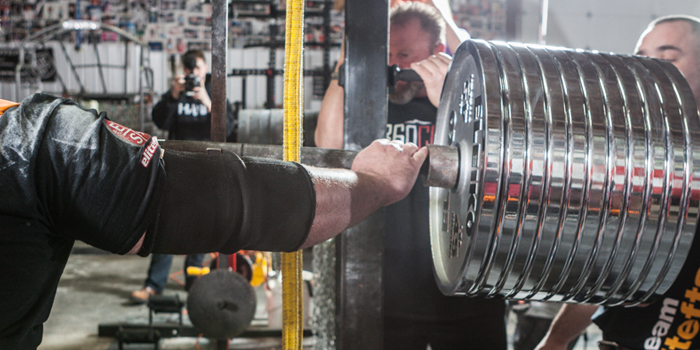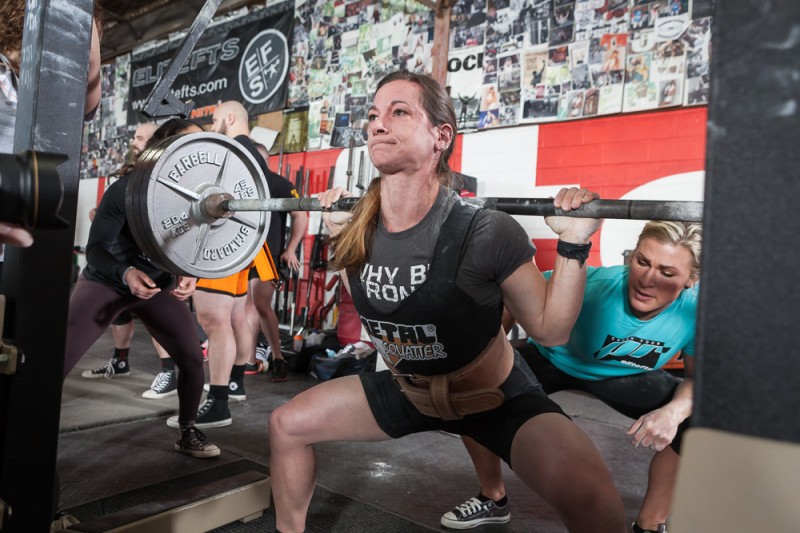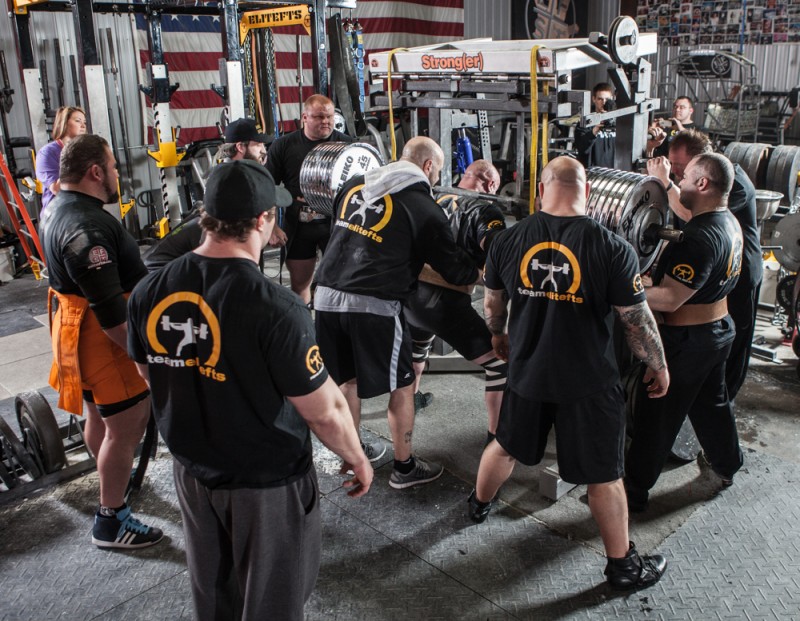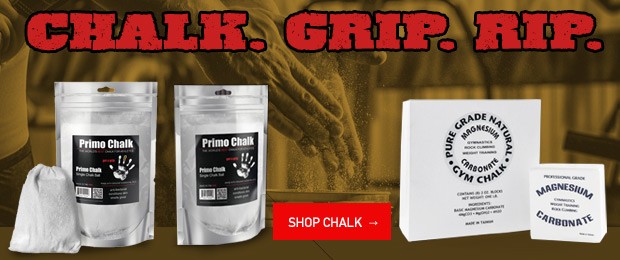
This article is published in conjunction with Building A Great Lifting Crew — Advice for Normal Lifters, which covers the same topic, written for lifters training in a commercial gym setting.
Much of what I'm going to write about here comes from what I've learned in my experiences during my time at Westside Barbell Club. Before that, I was a part of several different lifting crews, most of which were powerlifting crews. There were pros and cons with every one of them. The reason why I'm going to focus on the time that I was at Westside Barbell is I think that that was the best lifting crew that I've ever been a part of because of the dynamics, the progress, and the way it operated.
There are pros and cons to everything. It's very difficult for you to auto-regulate your training. When you're in a lifting group that's going to follow the concepts and the guidelines that I'm going to present, your ability to auto-regulate is very, very hard because the pressure is going to be very intense to be able to push forward. If you are very genetically inclined, being a part of a lifting group with this type of dynamic may not always be the best for you. At the same time, there's a really good chance, if that's the case, you're going to be the strongest person in a group, which makes it easier to auto-regulate anyhow, because you're leading the group without even knowing that you're doing so. This could make it the best thing for you. This all depends on the dynamics of the group and what the overall goal is.
Start with one. If you're just one person, find another one. It's that easy. That's how the sport's going to grow, anyhow. I'm continuously asked, "How can we make the sport larger?" Well, the answer is very simple. It all falls back onto personal responsibility. If you're a powerlifter, find another one. If every competitive lifter found one competitive lifter, you just doubled the sport. The personal responsibility is huge. Compete, go to meets, and try to find people that are local. If you've got to drive, then you drive to be able to train with them. It's a really weird sport because there are so many small gyms and there are so many garage gyms and basement gyms that you could have five or six people all within a five, ten mile radius of each other, all training for powerlifting, but you don't even know it.
RELATED: Oslo Performance Center — 'More Than Just A Hardcore Gym'
The only place you're going to find other lifters is by going to meets. You can try to find them by using social media, but good luck. If you're not friends with them, or know friends of friends, it's pretty much pointless. You go to a meet, you're more than likely to find people who are going to live closer to you. That would be the first recommendation. It's a stupid one, but it makes a lot of sense because it's so simple most people overlook this. When I think back to the time that I was at Westside, and we're talking between 1991 to 2005, I can think of at least three, maybe four times to where Louie, Chuck Vogelpohl, Kenny Patterson, and myself were sitting in the gym in the morning because we were the only ones left, looking around, asking each other, "What are we going to do? We need to find more people? Where are we going to find these people at?" Then organically it grows, and then you end up with a group of more people. Don't misunderstand, we still trained, but the goal was to have the strongest gym in the world. Ever. This is hard to do with four people.
You can't get discouraged because the numbers are small. If you continue to compete, you continue to keep your eye out for potential. Potential is guys that are lifting in other gyms, commercial gyms, who are strong but just really don't know that much about the sport. If you got something to offer, then they're going to want to come train with you.
Note: While I was the first to move to train with Louie at Westside Barbell there were over 50 elite total created there (there are many more now), national, world champions and multiple all-time word records with ALL the lifters being from the Columbus area. The majority from the Westside of Columbus.
When you do bring people in, bring them in slow. They've got to earn their place. They've got to earn their rank, so to say. I think other people that lifted who lifted at Westside Barbell have said that Chuck Vogelpohl didn't talk to them for six months until after they were there. I know I personally didn't give a shit to talk to anybody for at least two months. I didn't care. I'm there to take care of the people who I was training with and myself. If it's somebody new into the gym, they've got to earn the respect and the right to be able to be helped. Otherwise, it's a waste of everybody's time. If it's just going to be somebody that's going to show up and suck everybody's energy, and then not be able to give anything back, or they're going to be a puss, or they're not going to be able to represent, they don't deserve your attention. As Louie has stated hundreds or thousands of times:
" We know what Westside Barbell can do for you, what can you do for Westside?"
- Louie Simmons
Before we were to 100% engage in the new person, and start helping out, and helping 100% with the programming, and tweaking and changing every single flaw and every error that they have, we had to see if they would even show up. See if they train. See if they're consistent. See what their work ethic is like. Otherwise, you could pour your heart and soul out, and they're not going to stick. When you're pouring your heart and soul out, and spending your time trying to help that one person who just came in, you're not helping the other three or four that have been in your group for years.This is a BIG ask and a BIG trade. Is that new person worth it? Have they earned it?
Make them earn that. You don't need to come straight out and tell them. It is your responsibility to help them, and to make them better. What I'm saying is, you don't have to give them a two hour personal training session on how to be a better powerlifter every time they come in. Find one thing. Fix it. Find another thing. Fix it. Find another thing. Fix it. Take the time. When they start to show that they're going to show up, they're going to add value, and they're going to add something to the group, then engage.
Have everybody else engage to make them better, and then their lifts and their progress will increase exponentially. It's like a probationary period, if you want to call it that. When you do get somebody that's in the gym that is a virus, get rid of them. Don't even fuck around. If there is one thing that I think everybody that I trained with at Westside could agree with, thinking back on the people that we kicked out, we should have done it sooner. That was the one thing that we always said, every single time somebody had to get thrown out. It goes back to when I got in the business, the advice I kept getting when it came to employees was to hire slow, and fire fast. It's exactly the same concept. There have been a lot of things from training that I've learned that have carried over to business. That's one concept from business that I learned that we tried to do when building a group and training. It's one thing that has carried over in the other direction, in that regard.
Burn all egos at the stake. Training should be fun. It should be enjoyable. It shouldn't be about bowing down to one, and having to take care of every need of one specific lifter, just because they happen to be the best lifter in there. Fuck that. If that's the case and you have a prima donna in there, throw them the fuck out. Let them go see what they can do on their own. Get them the fuck out, because they're draining everybody else. You're only as strong as the weakest person in the gym. This is straight from Louie. They represent the gym. They represent the club. They're wearing the same fucking shirt you are when you go to a meet. When they're out at dinner, they're wearing the same shirt you are. When people are talking to them someplace, and they ask, "Where do they train," they're saying the same place you do. Whatever their strength level is, and whatever their potential is, it's your job to make sure they fully realize that.
They're not just representing themselves. They're representing the club that they're training with, and you. It's your job to get them stronger than you are. Then when they become stronger than you are, it will be their job to get you stronger than them. That has to be ingrained. That was one thing that Louie ingrained in every single one of our heads. Maybe it was ingrained in mine more than others. I don't know, but it was ingrained in my fucking head in a big way. I strongly felt that to be true, and I still strongly feel that to be true today. I think that if you can do that, then you can build a great club, because the wheel keeps building. It keeps becoming better.
Train the same way. I know people are going to disagree about this. This is where I started with talking about the inability of being able to actually auto-regulate. You have to have the energy and the positivity of the social dynamic of being able to train in a group. Training in a group becomes diluted when everybody's doing something different. If you've got one guy benching on Monday, for example, you've got two guys benching, one guy deadlifting, three guys are squatting — unless you got a really small gym, and everybody's right there in each other's face, you're going to lose a lot of the social dynamic that goes on with that. While people will have their criticisms about dynamic effort work, and say whatever they want to say about it, I disagree. That's for another post.
One thing that the dynamic effort method offers with the way that it's implemented is you have the social dynamic. If it is a bench press, for example, and you're benching on every 60 seconds, you can have three to four, even five, people benching in one group, and you're moving. As soon as one guy gets done benching, he's up and out, and then the next guy's in. It's this rotating circle to where you go from one guy who's on deck, one guy benching, one side spotter, one back spotter, and another side spotter, and this just keeps rotating around clockwise, with people changing weights. Before you even get to the bar, you're on deck. Your weight's already loaded. All you have to do is tighten your wrist wraps and go. Because of that energy and that social dynamic of everybody pushing and moving, the energy picks up. When that energy picks up, your ability to produce force is going to pick up as well. That social dynamic is huge when it comes to building a successful club, or gym, or powerlifting team, which is the question that was asked here. Max effort work kind of works along those same lines.
If you don't train using any kind of concurrent type of training, you can still get the same social dynamic using any type of periodization program, because the rest periods are a little bit longer, and the groups are longer. I've always trained in groups of three to five people when I've powerlifted, and we always train together. We didn't train in five different racks. It didn't matter how we trained. Many times, there were people doing different training programs, but we were still able to pull together to where everybody was doing the same movement at the same time. I do think that that is an important aspect.
MORE: How I Started a Hardcore Strength and Conditioning Gym in the UK
Have great equipment. I do understand that this is biased because I am in the strength equipment business, but the best lifters are going to gravitate to where the best shit is. They're not going to go to where there are shitty bars. They're not going to go where there are shitty stands. If they use a monolift, they're not going to go where there's not a monolift. If they use jack stands, they're not going to go where there are only power racks and no jack stands. You have to have quality equipment, and good bars, and the shit that they need to be able to get better. You're not going to be able to attract the group that you're looking for if you don't have what they need to be able to compete and get better. That's a simple concept, but it's overlooked.
When I speak to people who are trying to build clubs, they don't understand. It's like, "I'm trying to build this powerlifting team, and all they got are these shitty power racks." That's fine. All the power to you if you can do that, but if there are options with other groups and they've got better equipment that's going to match what they're going to compete with, that's where they're going to go. Out of all of it, the bars are going to be the most important. People are not going to go squat with shitty bars. It's just not going to happen.
Now, up until this point, what I've talked about is the training environment for a powerlifting group, specific to creating the best competitive powerlifters that you can. This advice has been for people who don't give a fuck about anything else in the gym except getting stronger. Nothing else. They're not there to socialize. They're not there to make friends. They're not there to catch up with people. They're not there to get a pump on. They're there to get fucking strong for meets, and that is it. In the other article also published today, I give advice on the same topic to the rest of the training population.













1 Comment